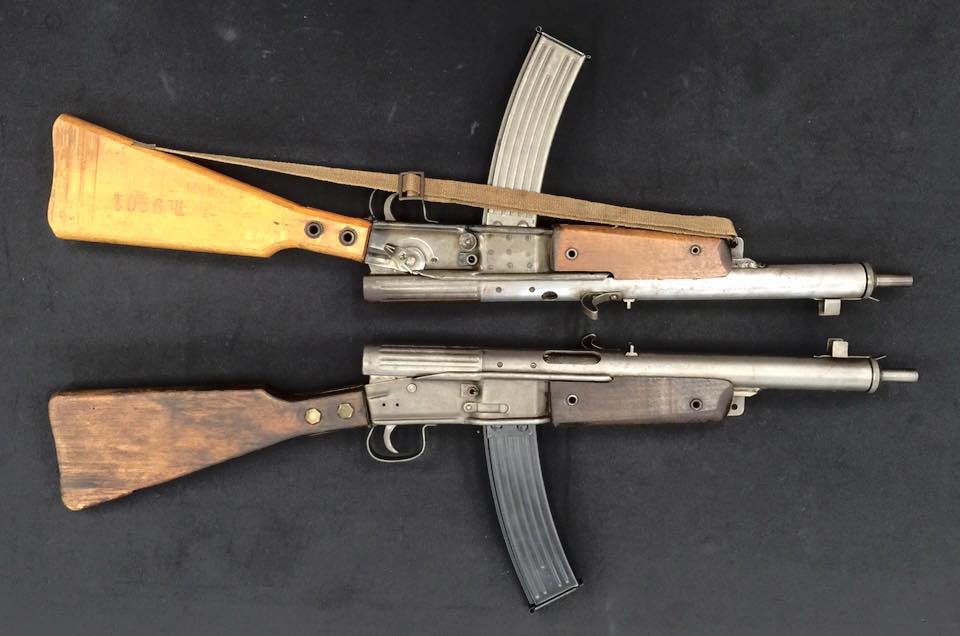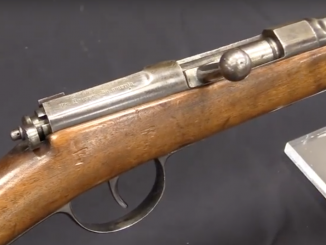With the advent of aircraft, marksmanship instruction gained a huge new element of complexity. Now there were gunners firing at rapidly moving aerial targets from the ground and worse, gunners in moving aircraft shooting at other moving aircraft! Classic shotgun sports were often used to train gunners to lead flying targets, but that wasn’t deemed sufficient by all countries. What was desired was a way for an instructor to actually see a student’s sight picture while firing.
The solution to this need was to build cameras which duplicated the handling characteristics of aircraft machine guns. The gun camera we are looking at today is an MGK-1000, which is made to simulate an MG-15 Luftwaffe machine gun. It is a movie camera, and each frame of film has a crosshair superimposed over it as well as an image of the vane sight’s position at the time the frame was exposed. This allows an instructor to see a record of exactly where the student was “shooting” and determine what corrections need to be made.
In addition to the camera functions, the MGK-1000 has elements intended to duplicate ancillary machine gun functions. For example, the spring that powers the camera is contained in a magazine body, and is weighted to duplicate the weight of a fully loaded magazine. The spring allows the camera to run as long as a 75-round drum would take to fire, at which point the trainee must swap it for a new “magazine” to continue “firing”.




Re: the rotating control knob to the left of the aperture selector, pointed out on the video as “not sure what this is”: did you try it out and note down what the other positions show (the detail picture in the lot description shows ‘H’)?
Based on the lot description, that knob could be the “cloud filter density” control, the other controls mentioned being readily identifiable (though the lot description does not mention the shutter position indicator) – if so, as a completely amateurish dabbler in photography equipment I would expect it to rotate a wheel of filters (UV and/or polarisation?) for a range of cloudiness levels, and indeed the front view seems to suggest such a wheel is right there in plain sight, with a toothed edge likely to be geared to the aforementioned knob.
In the still frames from the camera shown in the video you can see a timer. My wild guess for the left hand dial would be a control to zero that timer.
Hmm… Supposing I paired this camera with a “military police” vehicle-mounted MG-34, would the camera be useful in reducing the number of “disputable” cases of police brutality since everyone now seems to have cameras? Or would this backfire? Does anyone have a potential use for gun cameras without target kites?
This is one ingenious device. One remaining question would be what were the “hits” evaluated against. Was it a graduation on reticule which indicated sufficient lead?
Suppose there was an image caught on film against number of divisions on the scale in one direction or the other. Then of course also distance to target played its role. All in all, rather tricky proposition.
I don’t really know, but this camera seems to be a better idea than having a fresh trainee shooting a towed aerial target. If the trainee slipped up with a real machinegun, he might accidentally kill the target tug instead of that towed target (like hitting a friendly Ju-52 instead of the pesky PZL-11 attempting a Wronski Feint). With the camera, one could tell if the trainee were actually likely to hit the aerial target, miss the target, or perhaps hit the friendly by mistake without the risk of losing a target tug plane.